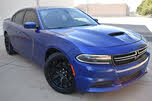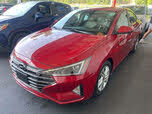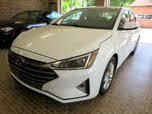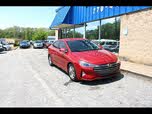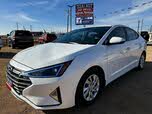2020 Dodge Charger vs 2019 Hyundai Elantra
Overview | ||
MSRP | $17,200 | $29,995 |
Average price | $13,203 | $26,439 |
Listings | ||
Ratings & Reviews | ||
User reviews | ||
Expert reviews | 8.2 out of 10Read full review | 8.5 out of 10Read full review |
Pros & cons | Pros
| |
Summary | Customer satisfaction is dependent on multiple factors. For example, let's say you go out to a new restaurant. Even if the service is great, or the bill is inexpensive, or the restaurant has a lovely ambiance, you probably won't go back if the food doesn't taste good. The updated and upgraded 2019 Hyundai Elantra is like that—unless you buy the turbocharged Sport trim. | The Dodge Charger represents an all-in-one approach to modern performance. Unlike its Challenger coupe counterpart, the Charger is a sedan, providing the usability of four full doors and five-passenger seating. It offers a wide variety of potent powertrains, as well as the availability of all-wheel drive (AWD). The Charger also provides the latest tech and infotainment features. It may be a classic nameplate, but it is a very different approach to the family sedan. This also makes it a breath of fresh air in the modern sedan market. Thanks to its wide variety of performance models, the Charger's exact competition is hard to pin down. V6-powered versions like the SXT and GT compete with the likes of the Toyota Avalon, Nissan Maxima, and Chevrolet Impala. But the available performance on tap with R/T and Hellcat models opens it up to a world of sports cars and muscle cars. Which model you select determines its rivals. No matter the trim selected, the Charger provides a baseline of athleticism paired with a spacious cabin, large rear seats, and a large trunk. Together, these make the Charger a fun and functional new car, with styling that helps it stand out in a crowd. |
Video | No video found | |
Popular Features & Specs | ||
Engine | 2.0L 147 hp I4 | 3.6L 292 hp V6 |
Drive Train | FWD | RWD |
Seating Capacity | 5 | 5 |
Horsepower | 147 hp @ 6200 rpm | 292 hp @ 6350 rpm |
MPG City | 26 | 19 |
MPG Highway | 36 | 30 |
Engine | ||
Engine Name | 2.0L 147 hp I4 | 3.6L 292 hp V6 |
Torque | 132 lb-ft @ 4500 rpm | 260 lb-ft @ 4800 rpm |
Horsepower | 147 hp @ 6200 rpm | 292 hp @ 6350 rpm |
Drivetrain | FWD | RWD |
Fuel Economy | ||
MPG City | 26 | 19 |
MPG Highway | 36 | 30 |
Interior | ||
Seating Capacity | 5 | 5 |
Safety | ||
Front Crash Overall | 4 | 4 |
Side Crash Overall | 4 | 5 |
Dimensions & Capacity | ||
Cargo Space | 14.4 cu ft | 16.5 cu ft |
Curb Weight | 2811 lbs | 3964 lbs |
Height | 56.5 in | 57.8 in |
Length | 181.9 in | 198.4 in |
Width | 70.9 in | 82.7 in |
Wheelbase | 106.3 in | 120.0 in |
Maximum Payload | 1136 lbs | |
Number of doors | 4 | 4 |
Maximum Towing Capacity | 1000 lbs | |
The 2019 Hyundai Elantra received a significant design update, featuring new styling elements forward of the windshield and front doors, redesigned wheels, and a revamped trunk lid, taillights, and rear bumper. While the previous model had a more conservative and upscale look, the 2019 version adopted a more geometric and kaleidoscopic design, which may not have been as universally appealing. Inside, the Elantra saw subtle improvements, such as new air vents, a carbon-texture finish on some plastic housings, updated gauges, and revised dashboard controls. These changes added a touch of excitement to the previously dull cabin, and the overall interior quality was high, with tightly assembled parts and a robust shifter.
In contrast, the 2020 Dodge Charger maintained its modern muscle car aesthetic, a design language that has evolved since the Charger name was resurrected in 2006. The 2015 facelift introduced a thin inlet grille and more aggressive headlights, which carried over to the 2020 model. The interior of the Charger blended retro themes with modern technology, featuring large vintage-looking bezels housing digital displays. The rear-wheel-drive platform necessitated a raised transmission tunnel, creating a cockpit-like feel for the driver and front passenger. The Charger offered various trims, each with unique visual and performance enhancements, from the base SXT to the high-performance Hellcat.
The 2019 Hyundai Elantra was equipped with a 2.0-liter 4-cylinder engine producing 147 horsepower, paired with a 6-speed automatic transmission driving the front wheels. While acceleration was acceptable, the driving dynamics did not inspire much excitement. The Elantra offered Normal, Sport, and Smart driving modes, but the Smart mode was not particularly perceptive, and the Sport mode added unwelcome weight to the steering. The EPA rated the Elantra at 32 mpg in combined driving, and real-world testing returned similar results. Handling was decent, with no significant praise or criticism for the steering and brakes, and the ride quality was somewhat busy due to the torsion-beam rear-axle suspension.
The 2020 Dodge Charger offered a range of powertrains, starting with a 3.6-liter V6 engine producing 292 horsepower in the SXT trim and 300 horsepower in the GT trim. The R/T trim featured a 5.7-liter Hemi V8 with 370 horsepower, while the R/T Scat Pack boasted a 6.4-liter Hemi V8 with 485 horsepower. The top-of-the-line Hellcat came with a supercharged 6.2-liter V8, delivering a staggering 707 horsepower. All engines were paired with an 8-speed automatic transmission, and AWD was available for the SXT and GT trims. The Charger excelled in performance, with the Hellcat offering exhilarating acceleration and the widebody models providing precise cornering thanks to Bilstein adaptive suspension and Brembo brakes. The Performance Pages feature allowed drivers to monitor and customize various performance aspects, enhancing the driving experience.
The 2019 Hyundai Elantra offered good front-seat comfort for a compact car, with height-adjustable seats for both the driver and front passenger. Most trims included heated front seats, a leather-wrapped steering wheel, and dual-zone automatic climate control. However, backseat comfort was less impressive, with hard plastic front seatbacks and a lack of air conditioning vents and USB ports. Interior storage was decent, with a sizable center-console bin, glove box, and door panel bins. The trunk provided 14.4 cubic feet of space, and the Smart Trunk feature allowed for hands-free access.
The 2020 Dodge Charger provided ample interior space, with well-bolstered front bucket seats and plenty of head- and legroom for both front and rear passengers. The rear seats offered generous legroom, even with the front seats slid back. The Charger featured helpful storage solutions in the doors and center console, and the trunk offered 16.5 cubic feet of space, which was above average for both performance sedans and large family sedans. The 60/40 split-fold rear bench allowed for additional storage flexibility.
The 2019 Hyundai Elantra, except for the base SE trim, came with a 7-inch touchscreen infotainment system featuring Apple CarPlay, Android Auto, and satellite radio. The Limited trim included an Infinity premium sound system, and the Ultimate Package added an 8-inch display, navigation, and SiriusXM Data Services. The infotainment system was user-friendly, with a good balance of knobs and buttons, and the Limited trim's audio system delivered impressive sound quality. The Value Edition and Limited trims also offered a free 3-year trial subscription to Blue Link services, providing a range of safety and convenience functions.
The 2020 Dodge Charger came standard with a 7-inch touchscreen infotainment system, while higher trims featured an 8.4-inch touchscreen. Both screen sizes ran the Uconnect system, which included Bluetooth, USB connectivity, satellite radio, HD radio, Apple CarPlay, and Android Auto. The Uconnect system was praised for its simplicity, with a lower dock of icons for easy navigation between functions. The digital display screen in the instrument panel provided additional information and was easy to operate via a directional pad on the steering wheel. The available navigation system offered turn-by-turn directions on this screen.
The 2019 Hyundai Elantra included several driver-assistance and collision-avoidance systems as standard equipment starting with the SEL trim. These features included forward-collision warning with automatic emergency braking, lane-departure warning with lane-keeping assist, blind-spot monitoring with rear cross-traffic alert, and a driver-monitoring system. The Limited trim added adaptive cruise control, pedestrian detection, automatic high-beam headlights, and a Safe Exit system. The Elantra received top marks from the IIHS, except for an Acceptable rating for LATCH anchor accessibility. The NHTSA gave the Elantra a 4-star overall rating.
The 2020 Dodge Charger came standard with front- and side-impact airbags, traction control, and rear parking sensors. Available safety features included forward-collision avoidance with automatic emergency braking, lane-departure warning, lane-keeping assist, adaptive cruise control, and automatic high-beams. Additional options included blind-spot monitoring, rear cross-traffic alert, and rain-sensing windshield wipers. The Charger's crash prevention technology earned a Superior rating from the IIHS, but many of these features were optional rather than standard.
CarGurus highlights

According to CarGurus experts, the overall rating for the 2019 Hyundai Elantra is 8.2 out of 10, while the 2020 Dodge Charger scores 8.5 out of 10. Based on these ratings, the 2020 Dodge Charger is the recommended choice, offering superior performance, a spacious interior, and a user-friendly infotainment system.
Choose the 2020 Dodge Charger if:
Shop Now- You desire a high-performance sedan with a range of powerful engine options.
- You need a spacious interior with ample legroom for rear passengers.
- You appreciate a user-friendly infotainment system with a logical menu layout and easy navigation.
Choose the 2019 Hyundai Elantra if:
Shop Now- You prioritize fuel efficiency and a lower starting price.
- You value a user-friendly infotainment system with standard Apple CarPlay and Android Auto.
- You seek a compact car with a high-quality interior and good front-seat comfort.

By: CarGurus + AI
At CarGurus, our team of experienced automotive writers remain at the heart of our content operation, conducting hands-on car tests and writing insightful guides that are backed by years of industry experience. To complement this, we are harnessing AI to make our content offering more diverse and more helpful to shoppers than ever. To achieve this, our AI systems are based exclusively on CarGurus content, ratings and data, so that what we produce is both unique to CarGurus, and uniquely helpful to car shoppers.













